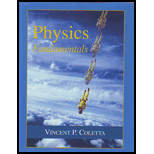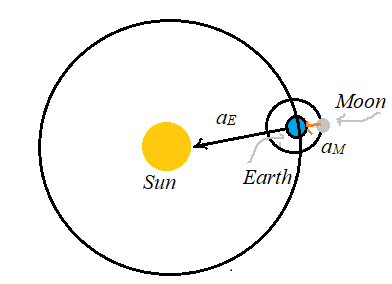
Concept explainers
(a)
The magnitudes of the velocity and acceleration of the Moon relative to the Earth.
(a)
Answer to Problem 40P
The velocity of the Moon as it travels in a circular orbit around the Earth is found to be
Explanation of Solution
Given:
The radius of the Moon’s orbit around the Earth,
The time period of revolution of the moon around the Earth,
Formula used:
The Moon travels a distance equal to the circumference of its orbit in the time equal to its time period. Its velocity
As it revolves around the Earth, it experiences a
Calculation:
Express the radius of the Moon’s orbit around the Earth in meters.
Express the time period of the Moon’s revolution around the Earth.
Substitute the values of
Substitute the values of
Conclusion:
Thus, the velocity of the Moon as it travels in a circular orbit around the Earth is found to be
(b)
The magnitudes of the velocity and acceleration of the Earth relative to the Sun
(b)
Answer to Problem 40P
The velocity of the Earth as it travels in a circular orbit around the sun is found to be
Explanation of Solution
Given:
The radius of the Earth’s orbit around the Sun,
The time period of revolution of the Earth around the Sun,
Formula used:
The Earth travels a distance equal to the circumference of its orbit in the time equal to its time period. Its velocity
As it revolves around the Sun, it experiences a centripetal force towards the center of its orbit. Its centripetal acceleration is given by,
Calculation:
Express the radius of the Earth’s orbit around the sun in meters.
Express the time period of the Earth’s revolution around the Sun.
Substitute the values of
Substitute the values of
Conclusion:
Thus, velocity of the Earth as it travels in a circular orbit around the sun is found to be
(c)
The value of the maximum acceleration of the Moon relative to Sun and the phase of the Moon this occurs.
(c)
Answer to Problem 40P
The value of the maximum acceleration of the Moon relative to Sun is found to be
Explanation of Solution
Given:
The acceleration of the Moon relative to Earth,
The acceleration of the Earth relative to the Sun,
The radius of the Earth’s orbit around the Sun,
The radius of the Moon’s orbit around the Earth,
Calculation:
The Moon revolves around the Earth in a circular orbit and the Earth revolves around the Sun. The Moon experiences accelerations relative to both Earth and the sun.
This is shown in the diagram below:

At New Moon day, the moon is farthest from the Sun and its acceleration towards the Earth and that towards the Sun point in the same direction. Hence, at this time, the accelerations add up and the Moon’s acceleration relative to the Sun is maximum.
Calculate the distance of the moon from the Sun when it is at its farthest position from the Sun.
The Moon’s distance from the Sun is nearly equal to the Earth’s distance from the Sun.
The Moon experiences an acceleration directed towards the Earth due its revolution around the Earth and since it moves around the Sun along with the Earth, it experiences an acceleration towards the Sun. During New moon day, the Moon, Earth and the Sun are in a straight line with the Moon at the farthest from the Sun. In this position, the acceleration of the Moon towards the Earth and towards the Sun are directed along the same straight line, towards the Sun. Hence, they add up.
Since the distance of the Moon from the Sun is nearly equal to that of the Earth’s distance from it, the Moon’s acceleration due its revolution around the Sun can be taken to be equal to that of the Earth’s around the Sun.
The Moon’s maximum acceleration in a direction towards the Sun
Substitute the values of the accelerations in the above expression.
Conclusion:
Thus, the value of the maximum acceleration of the Moon relative to Sun is found to be
Want to see more full solutions like this?
Chapter 3 Solutions
Physics Fundamentals
- For an object undergoing a uniform circular motion with radius 5.7 m and period 4.35 sec, the centripetal acceleration (m/s2) is:arrow_forwardAn ice skater is executing a figure-eight, consisting of two identically shaped, tangent circular paths. Throughout the first loop, she increases her speed uniformly, and during the second loop she moves at a constant speed. When the ice skater travels during the first loop, the acceleration vector is not directed towards the center, whereas when the ice skater travels in the second loop, the acceleration vector is directed toward the center. Is this true or false?arrow_forwardA projectile is shot straight up from the earth's surface at a speed of 1.00×104 km/hr .How high does it go?arrow_forward
- A particle travels around a circular path having a radius of 50 m. If it is initiallytraveling with a speed of 10 m/s and its speed then increases at a rate of a (v) = (0.05v) m/s 2 , thendetermine the magnitude of the particle’s acceleration four seconds later.arrow_forwardA marble slides down on a curved path defined by the parabola y = 0.4x2. When it is at point “A” (xA = 2m; yA = 1.6m), the velocity of the marble v = 8m/s and the tangental acceleration due to gravity is dv / dt = 4ms2. Calculate the normal component and the total magnitude of the accelarion of the mable in that instant.arrow_forwardAn experimental jet rocket travels around Earth along its equator just above its surface. At what speed must the jet travel if the magnitude of its acceleration is g?arrow_forward
- A pursue at radius 2.00 m and a wallet at radius 3.00 m travel in uniform circular motion on the floor of a merry-go-round as the ride turns. They are on the same radial line. At one instant, the acceleration of the pursue is (2.00 m/s^2)i + (4.00 m/s^2)j. At the instant and in unit-vector notation, what is the acceleration of the wallet?arrow_forwardA particle is in uniform circular motion about the origin of an xy coordinate system, moving clockwise with a period of 7.00 s. At one instant, its position vector (measured from the origin) is r: = (2.00 m)iˆ - (3.00 m). At that instant, what is its velocity in unit-vector notation?arrow_forwardAt a distance of 25 km from the eye of a hurricane, the wind is moving at 180 km/h in a circle. What is the magnitude of the centripetal acceleration, in metres per second squared, of the particles that make up the wind?arrow_forward
- If a particle moving in a circular path of radius 4.87 m has a velocity function v = 4t2 (units:m/s), what is the magnitude of its total acceleration at t = 1 s?arrow_forwardA proton has a speed 5x106m/s and is moving in a circle in the xy plane of a radius r = 0.175m.what is its position in the xy plane at time t= 2.0x10-7 s? at t= 0, the position of the proton is 0.175mî and its circles counter clockwise.sketch the trajectory.arrow_forwardThe earth has a radius of 6380 km and turns around once on its axis in 24h. a) What is the radial acceleration of an object on the ground at the earth’s equator? Give your answer in units of m/s and compare your result with the gravitational acceleration g. b) What is the radial acceleration of an object on the ground at the earth’s geographic North pole?arrow_forward
 University Physics Volume 1PhysicsISBN:9781938168277Author:William Moebs, Samuel J. Ling, Jeff SannyPublisher:OpenStax - Rice University
University Physics Volume 1PhysicsISBN:9781938168277Author:William Moebs, Samuel J. Ling, Jeff SannyPublisher:OpenStax - Rice University An Introduction to Physical SciencePhysicsISBN:9781305079137Author:James Shipman, Jerry D. Wilson, Charles A. Higgins, Omar TorresPublisher:Cengage Learning
An Introduction to Physical SciencePhysicsISBN:9781305079137Author:James Shipman, Jerry D. Wilson, Charles A. Higgins, Omar TorresPublisher:Cengage Learning

